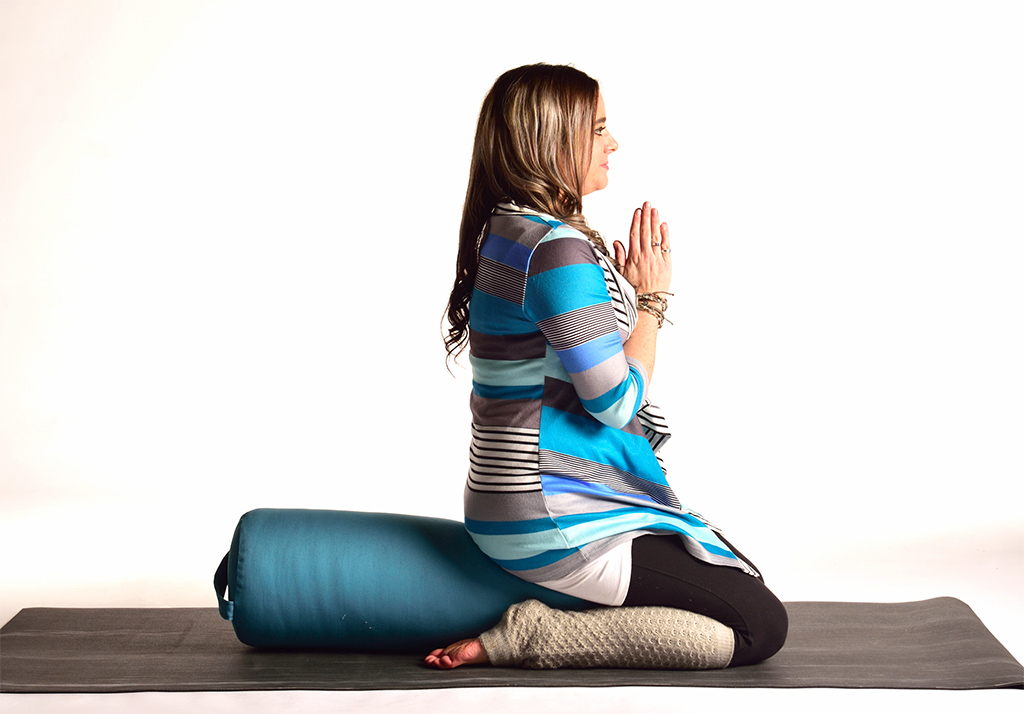
Hanuman, the monkey god, is one of yoga mythology’s most celebrated characters. His story is prominent in the Ramanayana, and he also plays a brief role in the Bhagavad Gita. He’s most famous for leaping from India to Sri Lanka to save Sita (wife of Rama). For this feat Hanuman merited a yoga pose in his name, Hanumanasana (a.k.a. splits). According to an article in Yoga International by Indian mythology expert, Zo Newell, for his strength, valor and courage, Hanuman earned the name “Vir Hanuman.” Here’s what Zo has to say about Hanuman and Virasana (Hero’s Pose):
“Hanuman, the monkey superhero of Indian legend, is widely known as ‘Vir Hanuman’ (Hero Hanuman). He is said to have two primary attributes. In relation to Lord Rama, he is both dasa (servant) and vira (hero). Some images of Hanuman emphasize his “vira” aspect: He leaps, he flies to the sun, he carries mountains, he performs impossible feats of strength and energy. But one of his most characteristic poses, one which shows his “dasa” side, is actually known to yoga students as virasana, hero’s pose.”
Virasana, then, was the pose Hanuman took when expressing his devotion to Rama.
Virasana Benefits
Hero’s Pose stretches the thighs and ankles, strengthens the arches, improves digestion and relieves gas, and can be therapeutic for high blood pressure. It also increases circulation to the lower body, rooting the energy in the pelvic floor and legs. It is one of yoga’s oldest asanas, a staple for meditation and pranayama practices.
Preparing to Practice Hero’s Pose
- To practice Virasana, gather a Yoga Mat, at least two Yoga Blankets, a Yoga Block and/or a Yoga Bolster.
- Before you start, practice a lunge such as Anjaneyasana to stretch your quadriceps muscles. A few standing poses such as Virabhadrasana I (Warrior I) or Virabhadrasana II (Warrior II) might also be helpful to warm up your quads.
How to Practice Hero’s Pose
- Place a folded blanket over your mat for extra padding.
- Start on your hands and knees. Place your knees an inch or so apart and separate your feet a little wider than hips-width.
- Place your palms on your calf muscles and press them down toward your shin bones. Still pressing, slide your hands back toward your ankles as you sit your hips down between your feet.
- Many, if not most, people can’t sit on the floor between their knees in the pose. If you have a known knee injury or if your knees feel ANY discomfort, please roll up another blanket and place it under your hips so that you are sitting higher. Alternatively, you can sit on a yoga block or yoga bolster.
- Keep adding height—blankets or a block—until you can sit comfortably. It’s important that your hips can ground easily here, so make sure you have enough height under your hips that you are not hovering over the floor or your block, blanket or bolster.
- If your knees feel compressed, try rolling up two thin washcloths and placing one behind each knee as you sit down into Virasana. This can create a bit of space behind your knees that might relieve discomfort.
- Once you have found a comfortable position, sit in Virasana for five to 10 easy breaths. Settle your hips down into your blankets or the floor. Feed your sit bones into the earth. Over time, you can increase your stay—as long as you are comfortable. When you are ready, move back to all fours and then into Uttanasana (Standing Forward Bend) or Adho Mukha Svanasana (Downward Facing Dog Pose).
Virasana Cautions
Donna Farhi says, “There’s no good knee pain.” The knees are strung together with ligaments. Any feeling of stretching or discomfort means that ligaments are stretching. Ligaments do not have the “memory” of muscles—they do not rebound when they are stretched. Over time, continual overstretching can destabilize your knee joints.
Virasana can help keep your knees nimble, but it is important to approach it with caution and respect. It can take years for some people’s hips to reach the floor, and if they never do that’s okay too. It’s far better to sit on blankets and enjoy healthy knees than to force yourself to the floor and risk injury. An experienced teacher can help you find your healthiest position.
Virasana’s circulatory benefits make it a great defense against frigid feet. It’s a great alternative to sitting cross-legged in meditation—as long as you give your body plenty of blanket, bolster or block support. Virasana invigorates our legs as it calms our body/mind energies.
